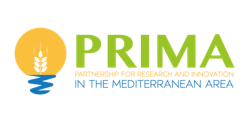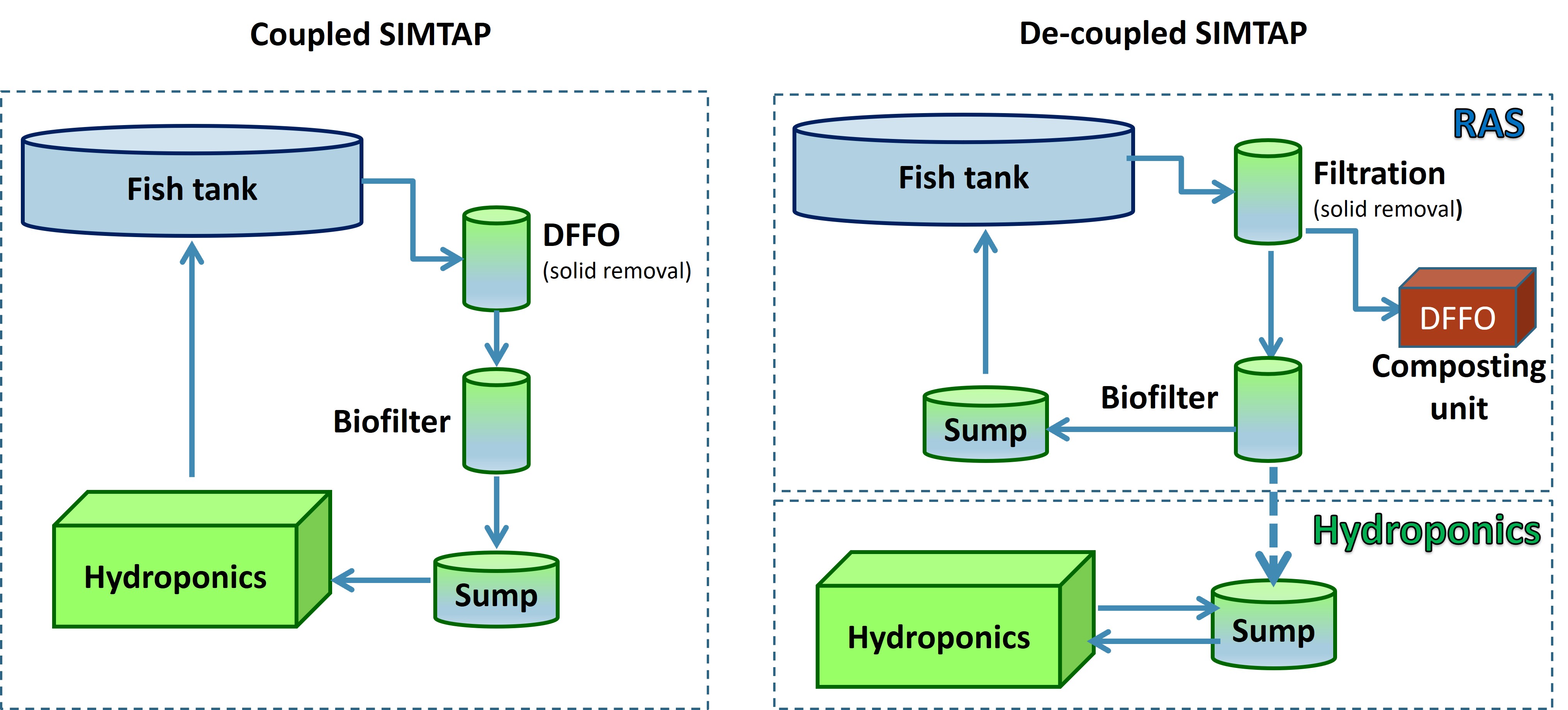|
Goals This project moved from the IMTA approach towards an innovative self-sufficient integrated multi-trophic aquaponic system (SIMTAP) for small scale, labour-intensive and environmentally friendly production of euryhaline fish species (gilthead sea bream and European sea bass) and halophytic plants (salicornia and sea beet) adapted to the typical socio-economic and climatic conditions of Mediterranean areas. The main goal of SIMTAP was to define, design, set up, and test an innovative food production system that drastically reduces, on one side, the required fish feed inputs (e.g., fishmeal, fish oil, soybean, etc.) and the consumption of water and energy, and on the other side the production of waste and pollution, decreasing the Life Cycle impact on the environment of this important segment of the food industry. Moreover, SIMTAP could re-use the effluents from greenhouse soilless cultivation for microalgae culture for both bioremediation of greenhouse wastewater and the production of biomass for feeding the intermediate organisms in the system. The main water source for the SIMTAP is seawater, as such or diluted, or brackish water as euryhaline fish species, can cope with different salinity levels. The SIMTAP systems were designed for implementation in different Mediterranean contexts, in terms of climate constraints, technological level, and potential integration with the existing greenhouses hydroponic and aquaculture systems. Moreover, the project aimed to evaluate the performance of the SIMTAP in terms of food production and use of energy, water, and other resources. Life Cycle Assessment (LCA), Life Cycle Cost (LCC), Social Life Cycle Assessment (SLCA), and energy and emergy accounting (EA) analysis were performed to quantify and compare the potential environmental impacts of the SIMTAP with conventional hydroponic and aquaculture systems.
Overview of the results and their exploitation and dissemination All the activities and deliverables reported in the proposal were completed on 31 May 2023. A one-year extension was necessary due to the COVID-19 pandemic. Four SIMTAP prototypes equipped with ISMACs were built in France, Italy, Turkey and Malta. The prototypes are available for future scientific and/or technological development activities and for educational purposes. The ISMaCS proved to be a reliable system for remote real-time monitoring and control of SIMTAP systems, and data storage. Seabream and seabass can be reared in SIMTAP systems with an alternative diet consisting of plant-based feed, mussels, clams and/or polychaete worms. In Italy, seabream reached the marketable size in nine months at 25 ppt salinity. In the SIMTAP tested in France, which hosted seabream, shrimps, oyster, and clam, the growth and survival rate of DFFOs were similar or even better than their performance in typical pond monoculture. Among the halophytes studied, salicornia is the most interesting species because of the high market price. The best salt concentration for this species grown hydroponically ranges between 10 and 20 ppt. The green seaweed Ulva rigida and the polychaete worm Nereis diversicolor adapted well to the SIMTAP. A decision support system aimed at defining the optimal location of SIMTAP installation was developed in a GIS environment. A multicriteria decision analysis model (DEXiAqua) was developed based on the indicators calculated with LCA, LCC, SLCA and EA and aimed at describing the performances of the three pillars (environmental, social, and economic) of sustainability in aquaculture systems. DEXiAqua demonstrated the overall improvement of environmental performances of SIMTAP compared to conventional fish farming systems. The methodology was published, and the calculator is available. The project results were disseminated by means of: project website (www.simtap.eu); 27 scientific publications, 8 workshops or seminars, 10 newsletters, and 6 videos (YouTube).
Conclusions on the project The SIMTAP concept has been tested and validated and the main bottlenecks were identified with reference to the intensive systems installed indoor or in greenhouse in Italy, Turkey, and Malta. These systems actually consisted of a RAS unit coupled with hydroponic unit together with tanks for the DDFOs. The rearing of DFFO and the optimal sizing of the different sub-systems (plants, seaweed, fish and DFFO) appeared the most limiting factors to the full application of the concept. Decoupled multitrophic aquaponic systems can overcome these difficulties. In decoupled systems, plants and/or seaweeds are grown in a separate compartment on the water discharged from the RAS unit, which also provides the organic matter to feed DFFOs cultured in an independent unit (see figure below). The culture of microalgae (Chlorella sp.) in low-cost photobioreactors was energy consuming and gave a low biomass productivity, thus an extensive and more-efficient system is required. The SIMTAP systems had better overall environmental performances than conventional systems due to fewer nutrient losses, lower carbon footprint, and less use of fish oil and fishmeal. The carbon footprint of SIMTAP system could be improved by enhancing the yield of each reared species and decreasing the energy consumption (quantity and quality). SIMTAP circularity should be considered not only at system scale but also at the territorial level to decrease the impact of feed production. The layout of coupled (one water loop) or decoupled (separate water loops) SIMTAP.
The encouraging results of ISMaCS allowed to design a prototype for commercial purposes. The DSS template, the implementation examples and the geodatabase has clearly shown the impact and legacy of the project, allowing to define the most suitable areas for a SIMTAP in various regions in the Mediterranean area, also assigning different weights to the criteria to prioritise various decision factors based on local needs and targets.
Socio-economic impact of the project The starting point of the project was a patented multitrophic aquaculture system (EP3171691A1), which was formulated without any validation and demonstration on a commercial scale. Thus, the initial Technology Readiness Levels (TRL) of the SIMTAP was 2 (technological concept formulated) and the expected output was 5 (technology validated in the relevant environment). It is therefore not possible to make a forecast on the economic impact of the project results. However, the SIMTAP has confirmed its ability to improve the sustainability of the aquaculture/aquaponics sector. From an environmental point of view, the most relevant aspect that emerged is the reuse of nutrients to produce a variety of products, adding value to the initial nutrient input provided by feed and improving the efficiency of the whole system with increased yield. On the economic side, excellent results have been achieved, mainly thanks to the large output of Salicornia that can be achieved and the significant economic value that polychaetes could have. Finally, from a social point of view, theoretical improvements have been achieved, especially if circularity and sustainability are considered not only at SIMTAP system scale, but also at a territorial/regional level, including other aquatic or agricultural value chains. The application of the results of the project could promote the development of on-shore aquaculture. SIMTAP represents a labour-intensive production system because the combination of hydroponics and aquaponics requires the use of manpower for the control and management of the two subsystems. In 2015, around 39,000 and 25,000 people worked in the aquaculture sector in the EU and in Turkey, respectively. Therefore, a 1% increase in EU and Turkish aquaculture production could create at least 600-650 direct jobs in five years after the end of the project together with 60-65 indirect jobs (assuming an activation coefficient of 0.10).
Link to PRIMA Observatory on Innovation (POI): https://primaobservatory.unisi.it/en/magazine/stories/simptap-aquaculture-low-environmental-impact-lower-production-costs |





